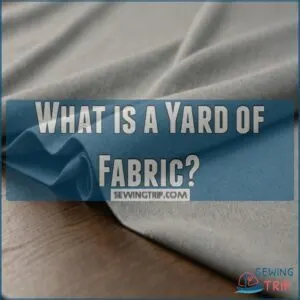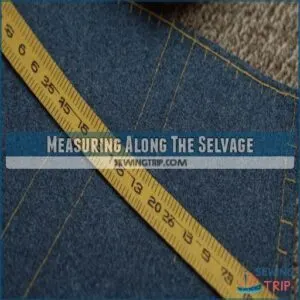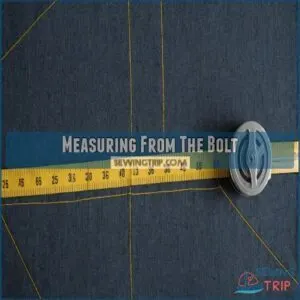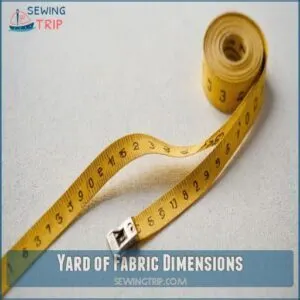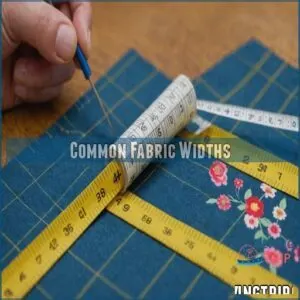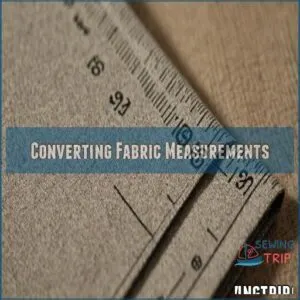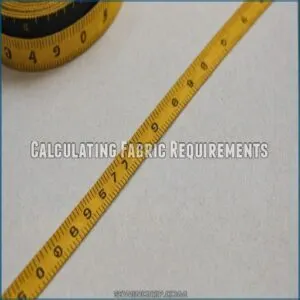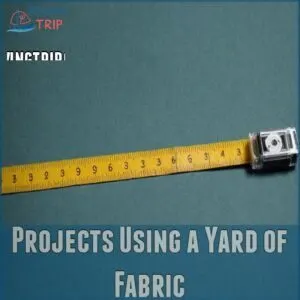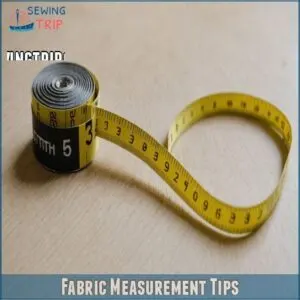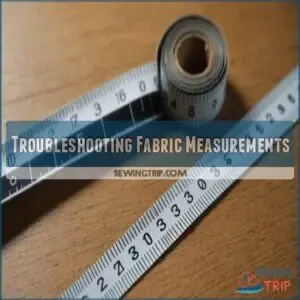This site is supported by our readers. We may earn a commission, at no cost to you, if you purchase through links.
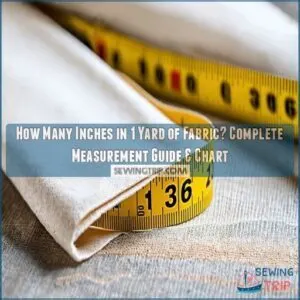
This standard measurement hasn’t changed since your great-grandmother’s sewing days.
When you’re at the fabric store, you’ll notice they measure along the selvage (that’s the finished edge) while the width varies from 36 to 60 inches, depending on the type of fabric.
Think of it like this: one yard is about the length of your outstretched arms, tip to tip.
Knowing these measurements will help you master your next sewing project, whether you’re crafting a cozy quilt or designing your own fashion statement.
Table Of Contents
- Key Takeaways
- What is a Yard of Fabric
- How Many Inches in a Yard
- Measuring a Yard of Fabric
- Yard of Fabric Dimensions
- Common Fabric Widths
- Converting Fabric Measurements
- Calculating Fabric Requirements
- Projects Using a Yard of Fabric
- Fabric Measurement Tips
- Troubleshooting Fabric Measurements
- Frequently Asked Questions (FAQs)
- Conclusion
Key Takeaways
- You’ll always find exactly 36 inches in one yard of fabric – this measurement is consistent and standardized across all fabric types and stores.
- You’ll measure fabric length along the selvage (finished edge), while the width can vary from 36 to 60 inches depending on the fabric type.
- You’ll encounter different standard widths: quilting cotton at 44 inches, apparel fabric at 45-60 inches, and home decor fabric at 54-60 inches wide.
- You’ll need to multiply your yard measurement by 91.44 to convert to centimeters, or by 0.9144 to convert to meters when working with international patterns.
What is a Yard of Fabric
You’ll find that a yard of fabric is always 36 inches in length, though its width can vary from 36 to 60 inches depending on the type you’re using.
Whether you’re crafting a cozy quilt or sewing a stylish dress, knowing these measurements will help you nail your fabric calculations every time.
Definition of a Yard of Fabric
A yard of fabric isn’t as mysterious as it might seem.
When you’re working with fabric, a yard is always 36 inches in length, measured along those finished edges called selvages.
Think of it like measuring a ribbon – you’re focusing on the length, not the width.
While widths can vary from 36 to 60 inches, that 36-inch length is your constant companion.
Fabric Measurement Systems
You’ll find two main systems for measuring fabric across the globe.
In the US, we stick to the Imperial system using yards and inches – it’s what you’ll see at most fabric stores.
But step into a shop overseas, and you’ll likely hear meters and centimeters (the metric system).
Don’t worry though – converting between the two is straightforward with some simple multiplication.
How Many Inches in a Yard
Understanding fabric measurements starts with getting inches and yards right.
A yard of fabric always equals 36 inches in length – think three rulers lined up end to end.
Getting this number locked in your head makes shopping and planning so much easier, especially when you’re grabbing supplies for your next project.
Considering fabric widths range from 28 inches to 60 inches or more, as shown in the fabric measurement guide, it’s also important to keep in mind that wider fabrics are generally more cost-effective and reduce wastage.
Here’s what every fabric enthusiast should know about yard measurements:
- One yard = 36 inches (no matter the fabric type)
- Half yard = 18 inches (perfect for smaller projects)
- Quarter yard = 9 inches (great for quilting blocks)
- Fat quarter = 18 x 22 inches (quilter’s best friend)
- Eighth yard = 4.5 inches (ideal for binding and trim)
When you’re eyeing that gorgeous bolt of fabric, remembering these numbers is like having a secret superpower.
They’re your building blocks for everything from quick repairs to ambitious quilting projects.
Measuring a Yard of Fabric
You’ll find that measuring a yard of fabric isn’t as tricky as untangling your earbuds when you know the proper technique.
Whether you’re working with cotton, silk, or wool, you’ll want to measure along the fabric’s selvage edge from the bolt, which gives you exactly 36 inches in length.
Measuring Along The Selvage
Measuring along the selvage edge guarantees accurate fabric measurements every time.
The selvage, that tightly woven edge running lengthwise, serves as your trusty guide.
For an easier fabric yard measurement process, consider using tools and products specifically designed for this purpose, such as those found in fabric yard measurement stores online fabric yard measurement tools.
Here’s a quick reference for different selvage types and their characteristics:
| Selvage Type | Purpose | Common Fabrics |
|---|---|---|
| Plain | Basic edge finishing | Cotton, linen |
| Decorative | Design element | Designer prints |
| Fringed | Prevents unraveling | Woolens, tweeds |
| Dense | Extra stability | Denims, canvas |
When measuring, always align your ruler parallel to the selvage for precise results.
Measuring From The Bolt
Fabric-measuring success starts at the bolt’s selvage edge, where accurate cuts make all the difference.
When you’re at the cutting counter, here’s what to watch for:
- Ask the clerk to straighten the fabric before measuring
- Keep the fabric flat and taut while measuring
- Follow the selvage edge, not the folded edge
- Double-check measurements before cutting
- Make sure the measuring tape is straight, not curved
Yard of Fabric Dimensions
You’ll find that a yard of fabric always measures 36 inches in length, though the width can range from 36 to 60 inches depending on the type you’re using.
Whether you’re making curtains or crafting a quilt, knowing these dimensions will help you avoid that frustrating moment when you’re short on fabric for your project.
Width of a Yard of Fabric
You’ll quickly notice that fabric width isn’t one-size-fits-all.
While a yard’s length stays constant, widths can vary greatly based on the type of fabric you’re working with, which is why you should check fabric width before purchasing fabric yardage.
Here’s a handy breakdown of standard fabric widths you’ll encounter:
| Fabric Type | Standard Width |
|---|---|
| Quilting Cotton | 44 inches |
| Apparel Fabric | 45-60 inches |
| Home Decor | 54-60 inches |
| Upholstery | 54-110 inches |
| Sheeting | 90-110 inches |
Length of a Yard of Fabric
The length of a yard of fabric stays constant at 36 inches, unlike its varying width.
Think of it as three rulers laid end-to-end – that’s your perfect yard every time.
Here’s what you’ll want to remember:
- A full yard measures exactly 36 inches (91.44 centimeters)
- Half yards come in at 18 inches
- Quarter yards stretch 9 inches
- Fat quarters give you 18 by 22 inches
- Pre-washed fabric might shrink slightly from these measurements
Common Fabric Widths
You’ll find that fabric widths aren’t one-size-fits-all, with most materials ranging from 44 to 60 inches wide depending on their intended use.
Whether you’re shopping for quilting cotton at 44 inches or home decor fabric at 60 inches wide, knowing these standard measurements will help you calculate exactly how much fabric you’ll need for your next project.
Sheeting and Home Decor Fabric
Sheeting and home decor fabrics typically come in 60-inch widths, giving you plenty of material to work with for those bigger projects.
When you’re picking out fabric for curtains, bedding, or upholstery, you’ll find this wider width saves both money and time – fewer seams to sew!
These fabrics often feature higher thread counts and special finishes for durability and wrinkle resistance.
Apparel Fabric Widths
When working with apparel fabrics, you’ll typically encounter varying widths that impact your yardage needs.
Most garment fabrics come in standard measurements, though the exact width depends on the type and intended use.
- Lightweight fabrics like chiffon and silk usually come in 45-inch widths
- Medium-weight cottons and linens are often 54 inches wide
- Stretchy knits and denim commonly measure 60 inches across
Quilting Cotton Fabric Width
Most quilting cotton comes in a standard 44-inch width, which you’ll find perfect for piecing together blocks and borders.
While some manufacturers might label it as 45 inches, you’re actually working with 42-43 inches of usable fabric after accounting for selvages.
This consistent width makes it easier to calculate your fabric needs and make sure your fat quarters measure the standard 18×22 inches.
You can find a wide variety of quilting fabric widths on this website, so be sure to check out their selection before you start your next quilting project.
Converting Fabric Measurements
You’ll need to switch between yards, meters, and inches when you’re working with fabric from different countries or following international patterns.
Whether you’re buying fabric online from overseas sellers or creating your own designs, knowing how to convert between measurement systems will save you from costly ordering mistakes.
Yards to Meters Conversion
Now that you’re working with international patterns, converting yards to meters is a breeze.
Simply multiply your yard measurement by 0.9144 to get meters, and don’t forget that a yard of fabric is 36 inches or 3 feet long.
Here’s what you need to remember:
- One yard equals 0.9144 meters (just shy of a full meter)
- Four yards is about 3.66 meters
- Ten yards converts to roughly 9.14 meters
Think of it this way: a meter is just a touch longer than a yard!
Yards to Centimeters Conversion
Converting yards to centimeters is simpler than you might think.
If you need a handy reference or products for measuring fabric yards to cm, check out online resources like fabric yards to cm tools.
Just multiply your yard measurement by 91.44, and you’ll have your centimeter equivalent.
For example, if you’re working with 2 yards of quilting cotton, that’s 182.88 centimeters.
While meters might be the go-to metric measurement, knowing your centimeters helps when you’re working with smaller pieces or following international patterns.
Yards to Inches Conversion
While centimeters are common worldwide, inches remain the go-to measurement in US fabric stores.
To switch yards to inches, just multiply your yard count by 36.
For example, 2.5 yards becomes 90 inches (2.5 × 36).
Working backward? Divide your inches by 36 to get yards.
So if you’ve got 72 inches of fabric, that’s exactly 2 yards (72 ÷ 36).
Calculating Fabric Requirements
You’ll save time and money when you know exactly how much fabric you need for your sewing projects, especially since fabric widths can vary from 36 to 110 inches.
Whether you’re making a simple mask or crafting a full quilt, you’ll want to calculate your fabric requirements based on both the length in yards and the width of your chosen material.
Importance of Fabric Width
Fabric width isn’t just a number – it’s your key to smart project planning and cost savings.
A yard of 60-inch wide fabric gives you 15 square feet to work with, while 45-inch wide fabric only provides 11.25 square feet.
That’s why checking the width before buying can save you money and prevent those frustrating moments of running short on material.
Estimating Fabric Needs
Beyond knowing standard measurements, getting your fabric needs right means thinking about the whole project.
You’ll want to factor in these key elements for accurate estimates:
- Project complexity – more pieces mean extra fabric for matching
- Pattern repeat – larger prints need additional yardage
- Fabric type – napped fabrics require buying more
- Shrinkage allowance – pre-washing can reduce fabric size up to 10%
Remember, it’s better to have a bit extra than to come up short!
Projects Using a Yard of Fabric
You’ll be amazed at how many creative projects you can tackle with just one yard of fabric, from stylish aprons to cozy pillowcases.
Whether you’re working with a 36-inch or 60-inch width, your yard of fabric can transform into wallets, children’s clothing, or even multiple face masks.
Sewing Projects for a Yard of Fabric
A single yard of fabric opens up endless possibilities for creative sewing projects.
You can whip up two stylish throw pillows, a chic apron, or several face masks from this amount.
To get inspiration for using up fabric scraps creatively, explore sewing projects with simple patterns.
For beginners, try making a simple tote bag or pencil case to practice your skills.
With 45-inch wide fabric, you’ll have enough material to create a basic skirt or shorts.
Crafting With a Yard of Fabric
A single yard of fabric opens up countless crafting possibilities!
You can create charming decorative bows, eye-catching wall hangings, or cozy pet beds.
Looking for quick wins?
Turn your yard into three stylish throw pillows, a set of placemats, or several festive bunting flags.
With clever planning, you’ll squeeze multiple projects from one yard, making every inch count.
Fabric Measurement Tips
You’ll be amazed at how much easier your sewing projects become when you master the art of accurate fabric measurement.
Whether you’re a beginner or seasoned sewist, these practical tips will help you avoid common measuring mistakes and save both time and money on your fabric purchases.
Measuring Fabric Accurately
To measure fabric like a pro, you’ll need three key tools: a clear ruler, measuring tape, and straight edge.
When measuring, keep your fabric flat on a clean surface and align your measuring tools with the selvage edge.
Don’t pull or stretch the fabric – let it lay naturally.
Use pins to mark your measurements, especially when working with slippery or delicate materials.
Avoiding Fabric Measurement Mistakes
When measuring fabric, little mistakes can lead to big headaches later. Here’s what to watch out for:
- Always measure from the bolt’s folded edge, not the cut end which might be uneven
- Double-check your ruler placement – it should be perpendicular to the selvage
- Keep consistent tension when measuring stretchy fabrics
- Don’t forget to account for shrinkage, especially with natural fibers
Troubleshooting Fabric Measurements
You’ll find it’s easier to fix fabric measurement mishaps when you understand the common pitfalls that even seasoned sewists face.
Whether you’re wrestling with wonky measurements or scratching your head over conversion calculations, we’ll help you get back on track with your project.
Common Fabric Measurement Errors
Measuring fabric isn’t always smooth sailing.
Common mistakes include mixing up yards with meters, forgetting to account for fabric width, and measuring off-grain instead of along the fabric width affects yardage.
You might also catch yourself misreading bolt labels or using the wrong conversion factors.
These slip-ups happen to even seasoned sewists, but knowing what to watch for can save you from measurement mishaps.
Resolving Fabric Measurement Issues
Found yourself with mismatched measurements? Don’t worry – every fabric mishap has a solution.
If your cuts aren’t lining up, double-check your ruler placement against the selvage edge.
For width discrepancies, measure at multiple points to find uneven edges.
Not sure about unit conversions? Keep a conversion chart handy or use a reliable fabric calculator app to avoid confusion.
Frequently Asked Questions (FAQs)
How many yards in a yard of fabric?
A yard of fabric is exactly one yard in length, straight as an arrow, measuring 36 inches from end to end.
You’ll find different widths available, but the length always stays true at 36 inches.
Is a yard a big piece of fabric?
A yard of fabric gives you plenty to work with – it’s 36 inches long and typically 45-60 inches wide.
You’ll have enough material for smaller projects like pillows, bags, or several face masks.
How do you measure a yard of fabric?
You’ll measure fabric length along the selvage edge from one point to another, marking 36 inches. The width varies by fabric type but remains constant while measuring the yard’s length.
How many centimeters in 1 yard of fabric?
A standard yard of fabric equals 44 centimeters in length, while the width can vary from 4 to 152 centimeters. You’ll find this measurement consistent across fabric stores worldwide.
How much do you get in a yard of fabric?
A standard yard of fabric gives you 36 inches in length, with widths typically ranging from 36 to 60 inches. You’ll get different amounts of usable material depending on the fabric’s width.
How many yards of fabric do you need for a pattern?
The amount of fabric needed depends on your pattern’s size requirements.
Check the back of your pattern envelope – it’ll list exact yardage based on your chosen size and fabric width.
What is the size of a yard of fabric?
A standard yard of fabric measures 36 inches in length, while the width varies between 36 to 60 inches depending on the type.
Most quilting cottons are 44 inches wide, and home decor fabrics stretch to 60 inches.
What does 2 yards of fabric look like?
Picture rolling out two sheets of fabric, each measuring 36 inches long. That’s 72 inches total, or 2 yards. Your fabric’s width depends on the type, usually ranging from 36-60 inches wide.
Is a yard of fabric 36 inches by 36 inches?
Fabulous fabric facts: A yard isn’t a perfect square!
While it’s 36 inches long, the width varies from 36 to 60 inches depending on the type.
You’ll often find common widths like 45 or 54 inches.
How do I measure one yard?
Measuring one yard of fabric is simple – just extend your fabric along a measuring tape or ruler for 36 inches in length.
You’ll want to measure straight down the selvage edge for accuracy.
Can fabric yards be purchased in decimal measurements?
While 90% of fabric stores sell in quarter-yard increments, you can purchase fabric in decimal measurements at specialty shops.
Just know that many retailers will round up to the nearest eighth or quarter yard.
Do fabric stores measure differently than craft stores?
No, both fabric and craft stores use standard measurements when selling fabric. You’ll find they measure along the selvage edge using the same 36-inch yard, regardless of the store type.
How does fabric stretching affect yard measurements?
Fabric stretching can alter your yard measurements considerably.
You’ll want to account for the fabric’s natural give when measuring, as stretchy materials like knits may expand up to 50% during handling and cutting.
Are fabric yards measured differently for delicate materials?
Despite what you might think, delicate materials are measured just like any other fabric – you’ll still use the standard 36 inches per yard.
Just handle them gently to avoid stretching or distortion during measuring.
Do international fabric suppliers use different yard measurements?
Most international suppliers use the metric system.
They’ll convert fabric measurements to yards (36 inches) for U.S. customers.
You’ll often see both measurements listed – it’s standard practice in global trade.
Conclusion
Mastering how many inches in 1 yard of fabric will transform you from a hesitant hobbyist into a confident crafter.
With 36 inches making up each yard, you’ll breeze through your next project like a seasoned pro.
Remember to measure along the selvage, account for fabric width variations, and keep this guide handy for quick reference.
Whether you’re quilting, sewing, or crafting, understanding these measurements is your key to creating beautiful, perfectly-sized pieces every time.

